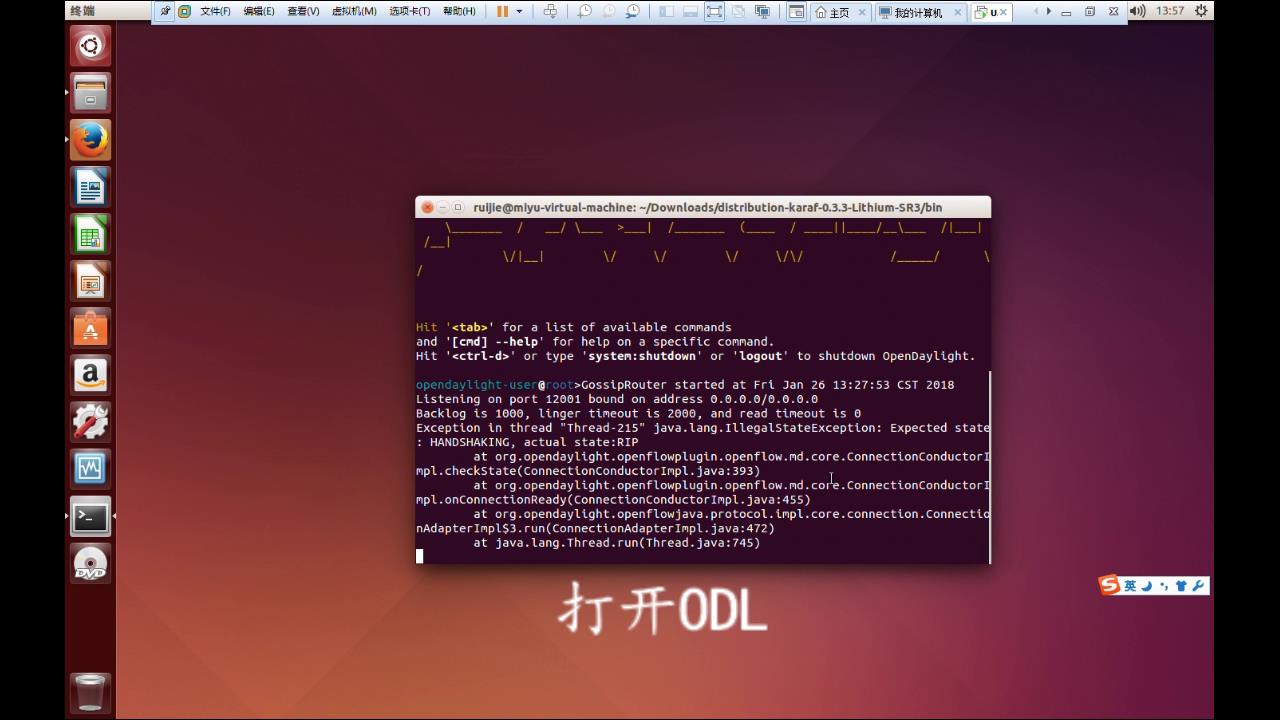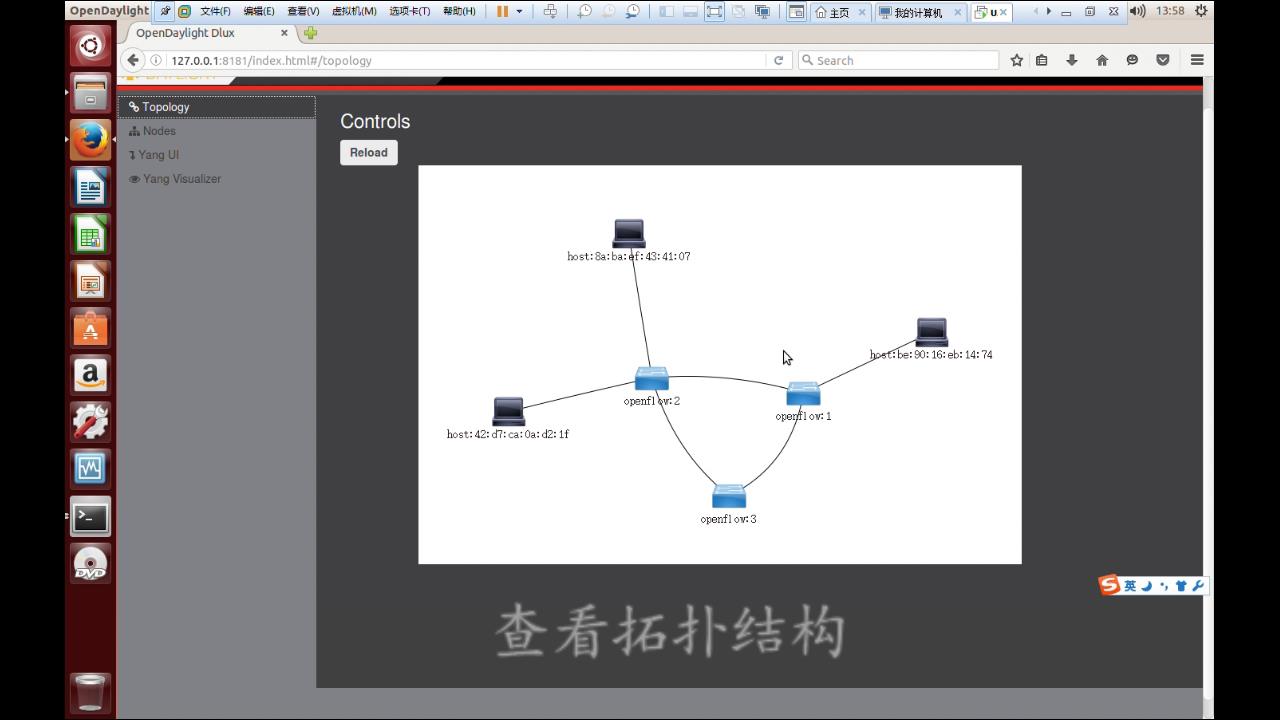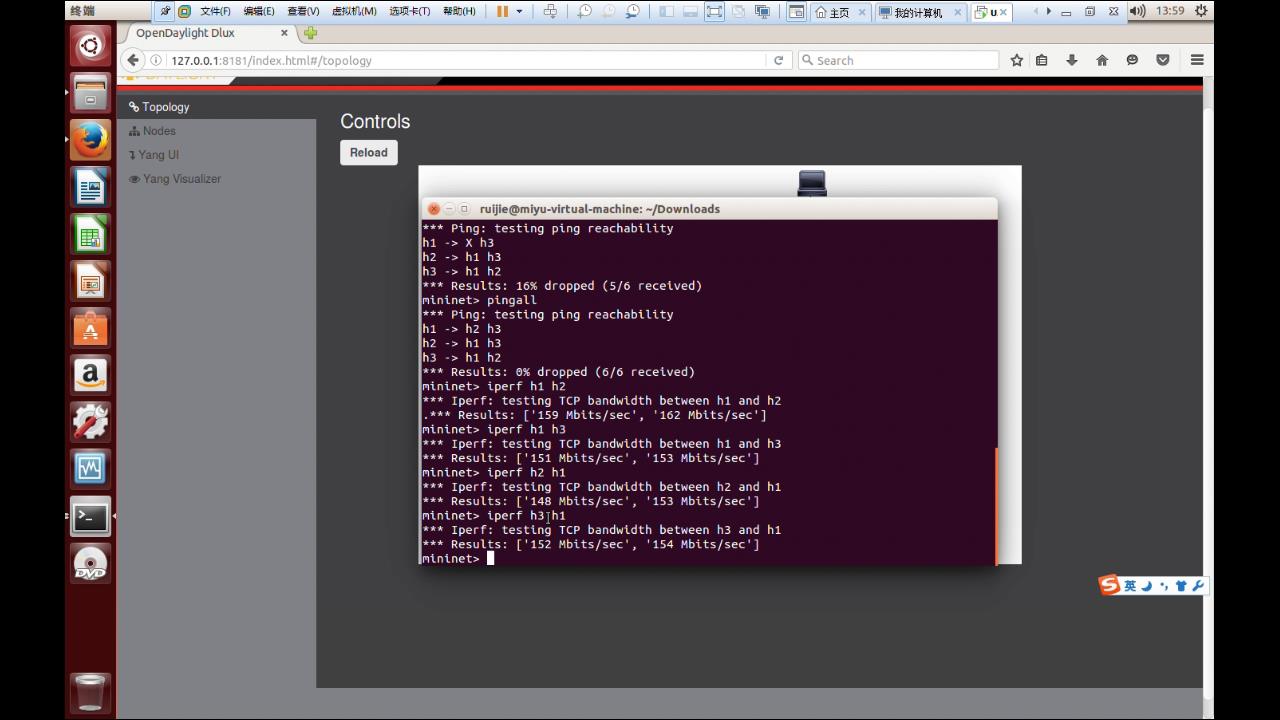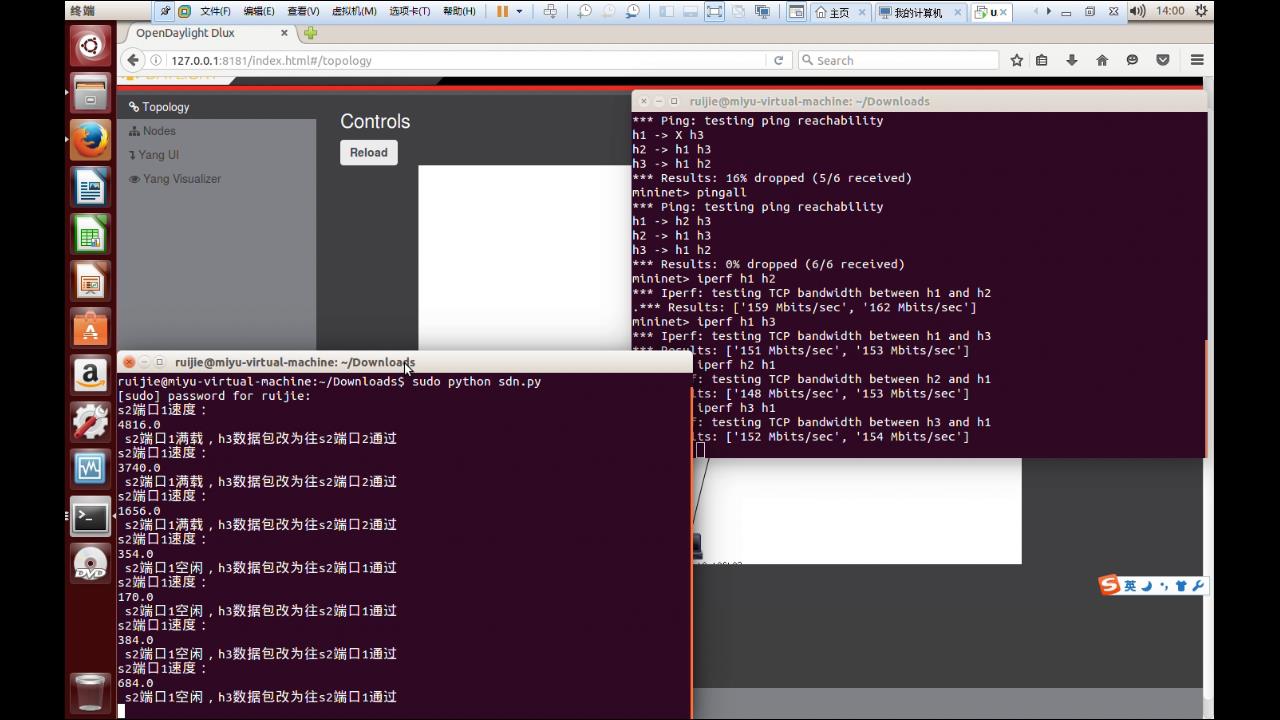一.实验代码
import httplib2
import time
import json
class OdlUtil:
url = ''
def __init__(self, host, port):
self.url = 'http://' + host + ':' + str(port)
def install_flow(self, container_name='default',username="admin", password="admin"):
http = httplib2.Http()
http.add_credentials(username, password)
headers = {'Accept': 'application/json'}
flow_name = 'flow_' + str(int(time.time()*1000))
#s2流表
#h2工作时s2端口1流量空闲时下发的流表
h2_to_s2_1 ='{"flow": [{"id": "0","match": {"ethernet-match":'
'{"ethernet-type": {"type": "2048"}},'
'"ipv4-source":"10.0.0.2/32","ipv4-destination": "10.0.0.1/32"},'
'"instructions": {"instruction": [{"order": "0",'
'"apply-actions": {"action": [{"output-action": {'
'"output-node-connector": "1"},"order": "0"}]}}]},'
'"priority": "101","cookie": "1","table_id": "0"}]}'
#h3工作时s2端口1流量空闲时下发的流表
h3_to_s2_1 ='{"flow": [{"id": "1","match": {"ethernet-match":'
'{"ethernet-type": {"type": "2048"}},'
'"ipv4-source":"10.0.0.3/32","ipv4-destination": "10.0.0.1/32"},'
'"instructions": {"instruction": [{"order": "0",'
'"apply-actions": {"action": [{"output-action": {'
'"output-node-connector": "1"},"order": "0"}]}}]},'
'"priority": "101","cookie": "1","table_id": "0"}]}'
mh3_to_s2_1 ='{"flow": [{"id": "1","match": {"ethernet-match":'
'{"ethernet-type": {"type": "2048"}},'
'"ipv4-source":"10.0.0.3/32","ipv4-destination": "10.0.0.1/32"},'
'"instructions": {"instruction": [{"order": "0",'
'"apply-actions": {"action": [{"output-action": {'
'"output-node-connector": "1"},"order": "0"}]}}]},'
'"priority": "100","cookie": "1","table_id": "0"}]}'
#h3工作时s2端口1流量满载时下发的流表
h3_to_s2_2 ='{"flow": [{"id": "2","match": {"ethernet-match":'
'{"ethernet-type": {"type": "2048"}},'
'"ipv4-source":"10.0.0.3/32","ipv4-destination": "10.0.0.1/32"},'
'"instructions": {"instruction": [{"order": "0",'
'"apply-actions": {"action": [{"output-action": {'
'"output-node-connector": "2"},"order": "0"}]}}]},'
'"priority": "101","cookie": "1","table_id": "0"}]}'
mh3_to_s2_2 ='{"flow": [{"id": "2","match": {"ethernet-match":'
'{"ethernet-type": {"type": "2048"}},'
'"ipv4-source":"10.0.0.3/32","ipv4-destination": "10.0.0.1/32"},'
'"instructions": {"instruction": [{"order": "0",'
'"apply-actions": {"action": [{"output-action": {'
'"output-node-connector": "2"},"order": "0"}]}}]},'
'"priority": "100","cookie": "1","table_id": "0"}]}'
#s3流表
s3_1='{"flow": [{"id": "0","match": {"ethernet-match":'
'{"ethernet-type": {"type": "2048"}},'
'"ipv4-source":"10.0.0.3/32","ipv4-destination": "10.0.0.1/32"},'
'"instructions": {"instruction": [{"order": "0",'
'"apply-actions": {"action": [{"output-action": {'
'"output-node-connector": "1"},"order": "0"}]}}]},'
'"priority": "101","cookie": "1","table_id": "0"}]}'
s3_2='{"flow": [{"id": "1","match": {"ethernet-match":'
'{"ethernet-type": {"type": "2048"}},'
'"ipv4-source":"10.0.0.1/32","ipv4-destination": "10.0.0.3/32"},'
'"instructions": {"instruction": [{"order": "0",'
'"apply-actions": {"action": [{"output-action": {'
'"output-node-connector": "2"},"order": "0"}]}}]},'
'"priority": "101","cookie": "2","table_id": "0"}]}'
#s1流表
s1_2To1='{"flow": [{"id": "0","match": {"ethernet-match":'
'{"ethernet-type": {"type": "2048"}},'
'"ipv4-source":"10.0.0.2/32","ipv4-destination": "10.0.0.1/32"},'
'"instructions": {"instruction": [{"order": "0",'
'"apply-actions": {"action": [{"output-action": {'
'"output-node-connector": "1"},"order": "0"}]}}]},'
'"priority": "101","cookie": "1","table_id": "0"}]}'
s1_3To1='{"flow": [{"id": "1","match": {"ethernet-match":'
'{"ethernet-type": {"type": "2048"}},'
'"ipv4-source":"10.0.0.3/32","ipv4-destination": "10.0.0.1/32"},'
'"instructions": {"instruction": [{"order": "0",'
'"apply-actions": {"action": [{"output-action": {'
'"output-node-connector": "1"},"order": "0"}]}}]},'
'"priority": "101","cookie": "1","table_id": "0"}]}'
#h1工作时s1端口2流量空闲时下发的流表
h1_to_s1_2 ='{"flow": [{"id": "2","match": {"ethernet-match":'
'{"ethernet-type": {"type": "2048"}},'
'"ipv4-source":"10.0.0.1/32","ipv4-destination": "10.0.0.3/32"},'
'"instructions": {"instruction": [{"order": "0",'
'"apply-actions": {"action": [{"output-action": {'
'"output-node-connector": "2"},"order": "0"}]}}]},'
'"priority": "101","cookie": "2","table_id": "0"}]}'
mh1_to_s1_2 ='{"flow": [{"id": "3","match": {"ethernet-match":'
'{"ethernet-type": {"type": "2048"}},'
'"ipv4-source":"10.0.0.1/32","ipv4-destination": "10.0.0.3/32"},'
'"instructions": {"instruction": [{"order": "0",'
'"apply-actions": {"action": [{"output-action": {'
'"output-node-connector": "2"},"order": "0"}]}}]},'
'"priority": "100","cookie": "3","table_id": "0"}]}'
#h1工作时s1端口2流量满载时下发的流表
h1_to_s1_3 ='{"flow": [{"id": "2","match": {"ethernet-match":'
'{"ethernet-type": {"type": "2048"}},'
'"ipv4-source":"10.0.0.1/32","ipv4-destination": "10.0.0.3/32"},'
'"instructions": {"instruction": [{"order": "0",'
'"apply-actions": {"action": [{"output-action": {'
'"output-node-connector": "3"},"order": "0"}]}}]},'
'"priority": "101","cookie": "2","table_id": "0"}]}'
mh1_to_s1_3 ='{"flow": [{"id": "3","match": {"ethernet-match":'
'{"ethernet-type": {"type": "2048"}},'
'"ipv4-source":"10.0.0.1/32","ipv4-destination": "10.0.0.3/32"},'
'"instructions": {"instruction": [{"order": "0",'
'"apply-actions": {"action": [{"output-action": {'
'"output-node-connector": "3"},"order": "0"}]}}]},'
'"priority": "100","cookie": "3","table_id": "0"}]}'
headers = {'Content-type': 'application/json'}
num=0
#下发流表,地址由ODL上获得
#下发s1与s3的流表
response, content = http.request(uri='http://127.0.0.1:8181/restconf/config/opendaylight-inventory:nodes/node/openflow:1/flow-node-inventory:table/0/flow/0', body=s1_2To1, method='PUT',headers=headers)
response, content = http.request(uri='http://127.0.0.1:8181/restconf/config/opendaylight-inventory:nodes/node/openflow:1/flow-node-inventory:table/0/flow/1', body=s1_3To1, method='PUT',headers=headers)
response, content = http.request(uri='http://127.0.0.1:8181/restconf/config/opendaylight-inventory:nodes/node/openflow:3/flow-node-inventory:table/0/flow/0', body=s3_1, method='PUT',headers=headers)
response, content = http.request(uri='http://127.0.0.1:8181/restconf/config/opendaylight-inventory:nodes/node/openflow:3/flow-node-inventory:table/0/flow/0', body=s3_2, method='PUT',headers=headers)
#s2调用h2到1的流表
response, content = http.request(uri='http://127.0.0.1:8181/restconf/config/opendaylight-inventory:nodes/node/openflow:2/flow-node-inventory:table/0/flow/0', body=h2_to_s2_1, method='PUT',headers=headers)
while num < 4 :
s1_uri = 'http://127.0.0.1:8181/restconf/operational/opendaylight-inventory:nodes/node/openflow:1/node-connector/openflow:1:2'
s2_uri = 'http://127.0.0.1:8181/restconf/operational/opendaylight-inventory:nodes/node/openflow:2/node-connector/openflow:2:1'
#获取s1端口2的流量
response, content = http.request(uri=s1_uri, method='GET')
content = json.loads(content)
statistics = content['node-connector'][0]['opendaylight-port-statistics:flow-capable-node-connector-statistics']
s1_bytes1 = statistics['bytes']['transmitted']
#0.5秒后再次获取
time.sleep(0.5)
response, content = http.request(uri=s1_uri, method='GET')
content = json.loads(content)
statistics = content['node-connector'][0]['opendaylight-port-statistics:flow-capable-node-connector-statistics']
s1_bytes2 = statistics['bytes']['transmitted']
s1_speed=float(s1_bytes2-s1_bytes1)/0.5
if s1_speed !=0 :#获取有效的速度
print ('s1端口2速度:')
print s1_speed
#在检测到s1端口2流量空闲时发的流表
if s1_speed < 1000 :
print(' s1端口2空闲,h1数据包改为往s1端口2通过')
response, content = http.request(uri='http://127.0.0.1:8181/restconf/config/opendaylight-inventory:nodes/node/openflow:1/flow-node-inventory:table/0/flow/2', body=h1_to_s1_2, method='PUT',headers=headers)
response, content = http.request(uri='http://127.0.0.1:8181/restconf/config/opendaylight-inventory:nodes/node/openflow:1/flow-node-inventory:table/0/flow/3', body=mh1_to_s1_2, method='PUT',headers=headers)
#在检测到s1端口2流量满载时发的流表
else :
print(' s1端口2满载,h1数据包改为往s1端口3通过')
response, content = http.request(uri='http://127.0.0.1:8181/restconf/config/opendaylight-inventory:nodes/node/openflow:1/flow-node-inventory:table/0/flow/2', body=h1_to_s1_3, method='PUT',headers=headers)
response, content = http.request(uri='http://127.0.0.1:8181/restconf/config/opendaylight-inventory:nodes/node/openflow:1/flow-node-inventory:table/0/flow/3', body=mh1_to_s1_3, method='PUT',headers=headers)
#获取s2端口1的流量
response, content = http.request(uri=s2_uri, method='GET')
content = json.loads(content)
statistics = content['node-connector'][0]['opendaylight-port-statistics:flow-capable-node-connector-statistics']
s2_bytes1 = statistics['bytes']['transmitted']
#0.5秒后再次获取
time.sleep(0.5)
response, content = http.request(uri=s2_uri, method='GET')
content = json.loads(content)
statistics = content['node-connector'][0]['opendaylight-port-statistics:flow-capable-node-connector-statistics']
s2_bytes2 = statistics['bytes']['transmitted']
s2_speed=float(s2_bytes2-s2_bytes1)/0.5
if s2_speed !=0 :#获取有效的速度
print ('s2端口1速度:')
print s2_speed
#在检测到s2端口1流量空闲时发的流表
if s2_speed < 1000 :
print(' s2端口1空闲,h3数据包改为往s2端口1通过')
response, content = http.request(uri='http://127.0.0.1:8181/restconf/config/opendaylight-inventory:nodes/node/openflow:2/flow-node-inventory:table/0/flow/1', body=h3_to_s2_1, method='PUT',headers=headers)
response, content = http.request(uri='http://127.0.0.1:8181/restconf/config/opendaylight-inventory:nodes/node/openflow:2/flow-node-inventory:table/0/flow/2', body=mh3_to_s2_2, method='PUT',headers=headers)
#在检测到s2端口1流量满载时发的流表
else :
print(' s2端口1满载,h3数据包改为往s2端口2通过')
response, content = http.request(uri='http://127.0.0.1:8181/restconf/config/opendaylight-inventory:nodes/node/openflow:2/flow-node-inventory:table/0/flow/1', body=mh3_to_s2_1, method='PUT',headers=headers)
response, content = http.request(uri='http://127.0.0.1:8181/restconf/config/opendaylight-inventory:nodes/node/openflow:2/flow-node-inventory:table/0/flow/2', body=h3_to_s2_2, method='PUT',headers=headers)
odl = OdlUtil('127.0.0.1', '8181')
odl.install_flow()
二.实验场景

服务器h2 h3上各自有不同的服务,h1是客户端。实现一个负载均衡的北向程序,当h2和h3向h1传输数据时,北向应用根据链路的使用状况动态的调整路由规则。
主要思路:过一定的时间后,下发新的流表,使得流量流向另一个交换机,从而实现负载均衡。类似于轮询法。
三.视频演示
1.打开ODL

2.查看创建的拓扑

3.查看拥塞情况

4.调用负载均衡

5.调用后的结果

三.小组分工
负责查找相关资料分析各路由和服务器间的链接关系,编写和修改python代码,在实现过程中与组员一起修改下发流表的代码。
四.课程总结
**1.了解了SDN的定义和发展。SDN与传统网络的区别和SDN的特点以及为什么需要SDN。软件定义网络(Software Defined Network, SDN ),是Emulex网络一种新型网络创新架构,是网络虚拟化的一种实现方式,其核心技术OpenFlow通过将网络设备控制面与数据面分离开来,从而实现了网络流量的灵活控制,使网络作为管道变得更加智能。 **
2.在mininet上创建简单拓扑并验证其正确性。运用Floodligth查看创建的拓扑及其链接结构。Mininet是由一些虚拟的终端节点(end-hosts)、交换机、路由器连接而成的一个网络仿真器,它采用轻量级的虚拟化技术使得系统可以和真实网络相媲美。
3.对Openflow流表的使用。多级流表将数据包的处理逻辑划分为多个子逻辑,并由多张流表分别来匹配和处理,从而使得数据包的处理变成了一条流水线。单流表是无法满足复杂的业务逻辑要求的。
4.利用字符界面下发流表,通过测试联通性,来验证openflow的hardtime机制。运用OVS命令查看流表。
5.学习了ODL控制器的使用及在ODL上下发流表。
6.用Wireshark抓包验证实验的正确性。
7.用Postman通过ODL的北向接口下发流表。
8.对负载均衡的定义及实现有了掌握,了解了负载均衡的几个基本算法,对较简单的负载均衡场景可以实现。